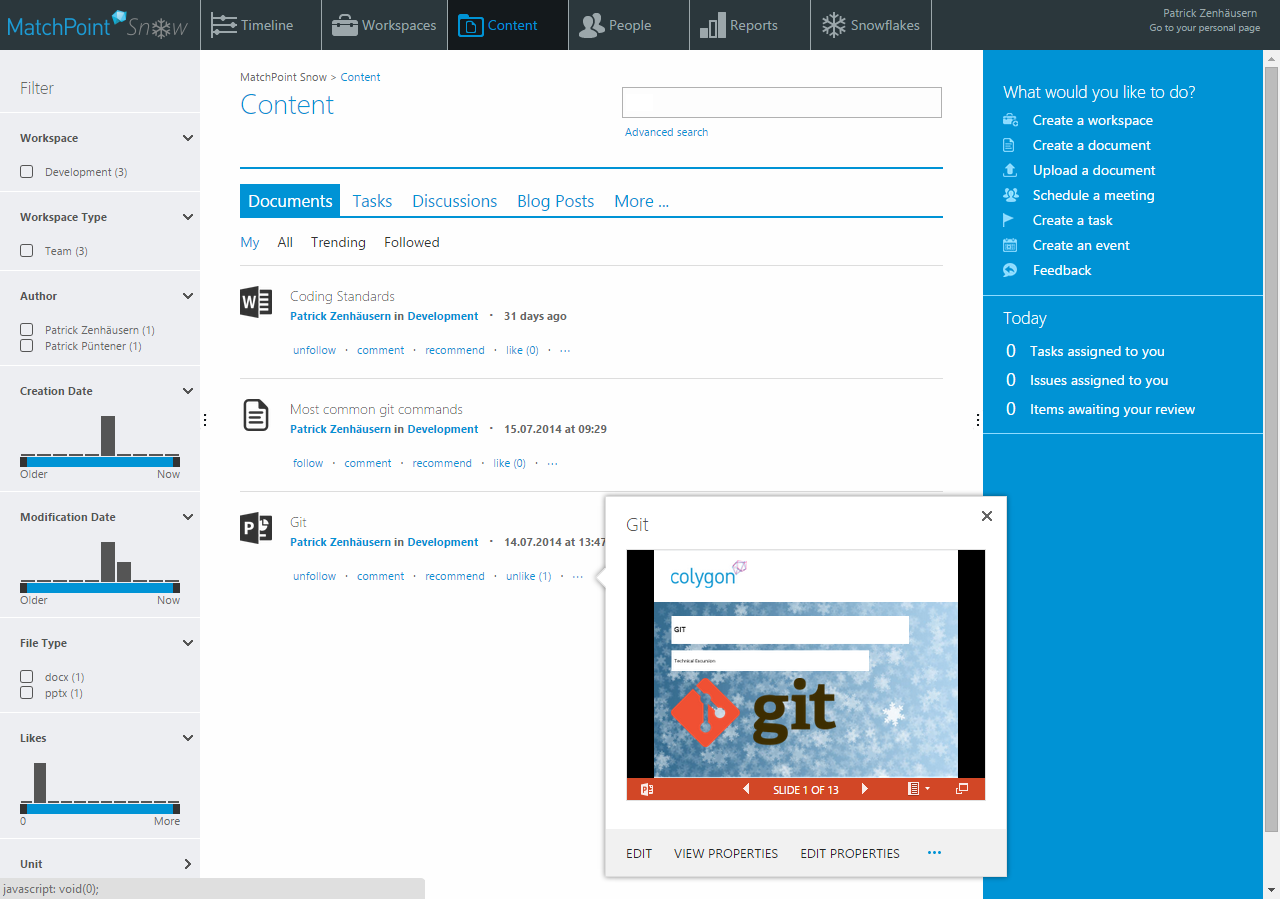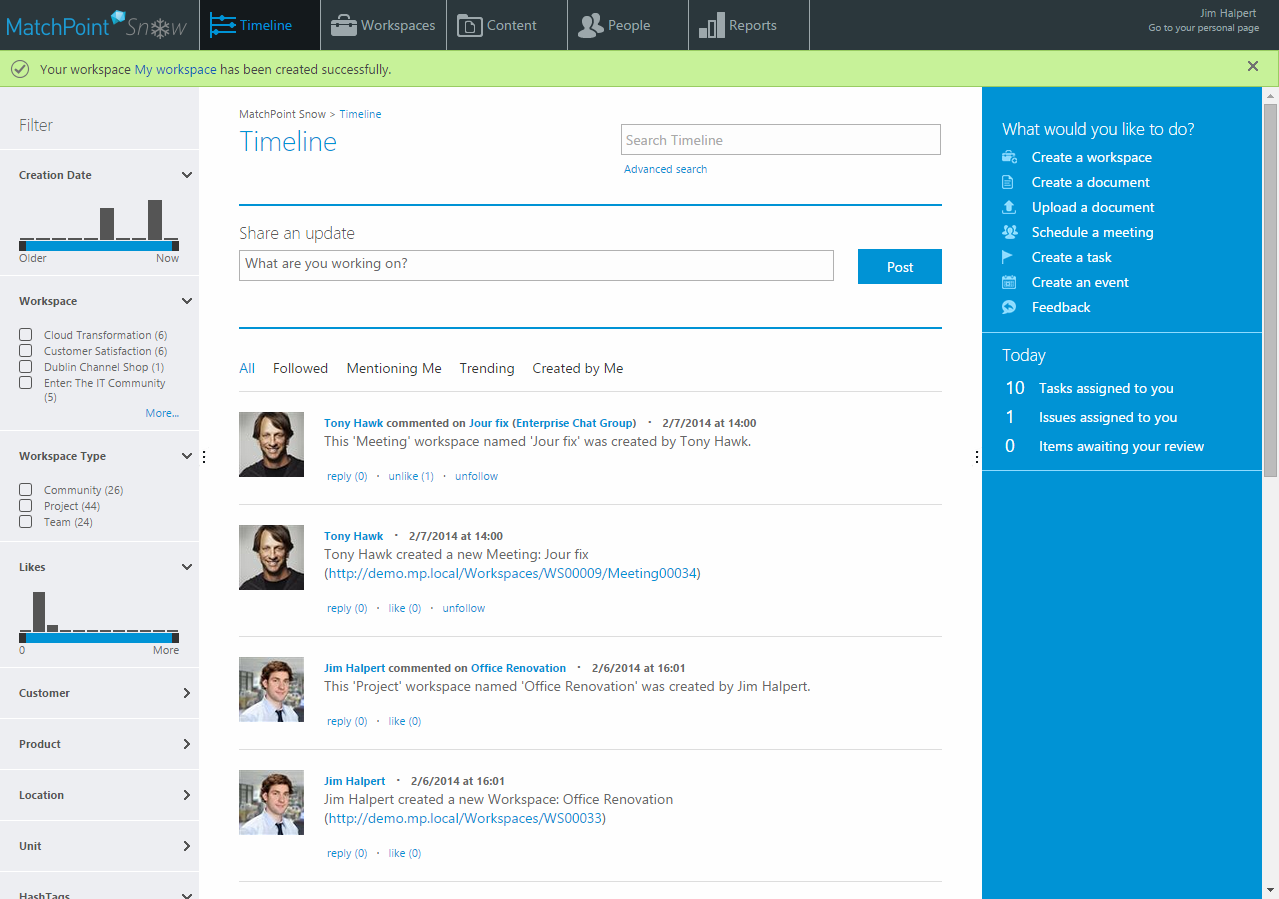What's New
MatchPoint Intranet
OWA Support
Since MatchPoint 4.0.6, it's possible to use the OWA (Office Web Apps) functionality. This functionality can display a live preview of various document types inside callouts and allows it to edit documents directly in the browser. MatchPoint Snow makes use of this inside DataGrids, Composites, and the advanced search.
For example, this Screenshot is taken from the "Content"-view of MatchPoint Snow:

To configure and use this feature, SharePoint must be able to connect to an Office Web Apps Server.aspx) in your environment.
Navigation improvements
In this new release we added many navigation improvements:
- Improved breadcrumb
- Files and folders from documents libraries are now also displayed
- General improvements
- Workspace navigation
- A content node (which links to site content) is displayed
- The current node is highlighted
- All configured navigation nodes are displayed recursively (not just the first level)
- Top navigation
- MatchPoint Snow is now also shown as a Snowflake
- All Snowflakes automatically have the "Snowflake"-node (so it's possible to directly navigate between different Snowflakes)
Display standardized status messages
MatchPoint Snow now uses a StatusBar to display status messages / result of operations in a unified and user-friendly way. The StatusBar is just a slightly modified version of the default SharePoint StatusBar. The StatusBar is shown right below the top navigation of MatchPoint Snow.

We encourage all Snowflake developers to use the StatusBar to display messages. MatchPoint Snow provides helper methods which can be used. The Snowflake Developer Guide will soon be updated and show exactly how you can and should use the new StatusBar.
Update, 18.12.2014: The Snowflake Developer Guide has been updated. It is available for partners in the download section.
Composed Look: Custom color slot keys
Since the default color slot keys did not satisfy the needs of MatchPoint Snow anymore, we introduced a complete set of custom color slot keys. These new keys have the big advantage that they now have fitting names (that exactly describe the purpose of the slots). Moreover, the different color regions in Snow are now better differentiable. This improvement makes it easier to provide an own composed look. If you want to know more about composed looks check out this post. Also, we will soon publish a separate blog post about the new custom color slots.
Workspaces owner role tag
All workspaces now use the role tag functionality of MatchPoint for the owner role. This has the advantage that all workspaces are now refinable by owners. Before it was only possible to refine workspaces by their author (creator of the workspace).
Adjustments regarding Composed Looks
With version 1.0.4 MatchPoint Snow has changed its concept regarding composed looks:
Up to now default SharePoint keys for the color slots were used. It was now decided to use our own slots. The reason for this is that more speaking names can be used, which actually describe where they are used in MatchPoint Snow. This make it easier to create a composed look for MatchPoint Snow. However, there are a few exceptions where the out of the box SharePoint slot keys are still used.
In case you already have a composed look for MatchPoint Snow or for any solution on Snowflake based on MatchPoint Snow, you need migrate it to use the new color slot keys. The same is the case with any CSS file in which the new color slot keys should be referenced. MatchPoint Snow provides two PowerShell Cmdlets which help to perform this migration:
Translate-MPSCssFile
This Cmdlet iterates over the specified source CSS file and looks for the directives containing a "themeColor" (ReplaceColor and RecolorImage). The values will then be replaced with the new value.
If more than one value can be applied, the possible values will be written in comment behind the actual CSS statement. The replacement then needs to be made manually.
Please see following example showing the comment containing the possible values:
.a-css-selector {
/* [ReplaceColor(themeColor:"StrongLines")] */ border-topcolor: #0093d5 !important;
/* Matching color slot keys: StrongLines, MPSContentSep aratorLine, MPSRefinementSliderSelectedRange */
}
Following Parameters need to be specified:
- SourceFilePath: The path to the CSS-file using the regular SharePoint color slot keys.
- TargetFilePath The file path where the created file will be written to.
Please revise the file after the translation and perform any necessary manual changes.
Translate-MPSColorFile
This Cmdlet translates an existing spcolor file (using the out of the box SharePoint color slot keys) to the new MatchPoint Snow format. That means that the new colorslot keys are added and are filled with the correct value, based on the old color used.
Following Parameters need to be specified:
- SourceFileUrl: The URL to an spcolor file which needs to be translated to use the new MatchPoint Snow color slot keys.
- TargetFilePath: The file path where the created file will be written to.
Reapply-MPSComposedLook
In case the current composed look needs to be reapplied to MatchPoint Snow or a specific web, the
Cmdlet Reapply-MPSComposedLook can be used.
Following Parameters need to be specified:
- WebApp The URL to the web application which hosts MatchPoint and MatchPoint Snow. If this parameter is specified, then the composed look will be reapplied on all webs belonging the current Snow Application.
- WebUrl: The URL to a specific web on which the composed look should be reapplied.
- Recursive: If the WebUrl parameter is specified, the recursive flag indicates whether all child webs should be processed as well.
OWA Support
As of MatchPoint version 4.0.6, Office Web Apps are supported. The SharePoint farm needs to be linked to an OWA server in order for this to work. This can be done by running following Cmdlet:
New-SPWOPIBinding -ServerName "server.name.com"
Once the SharePoint farm is linked to an OWA server, MatchPoint will display previews of documents in a callout within search results and within data grids showing documents. For this reason, MatchPoint uses a callout instead of a popup item for the context menu as of version 4.0.6.
MatchPoint Snow benefits of these changes as well and displays these previews.
Position of the „Go to list"
context menu item MatchPoint Snow provides an own context menu item "Go to List". This action is shown in datagrid- and some composite-webparts.
Until Snow 1.0.4 the "Go to list" context menu item entry was just appended to the context menu.
Now it can be positioned at the top. If you want that you have to change the MatchPointConfiguration.xml:
MatchPointConfiguration -> DataGridContextMenus -> DataGridContextMenu -> MenuItem
Set the Id to "MPSConstants.GoToListMenuItemId"